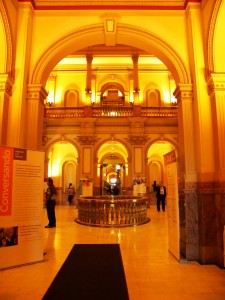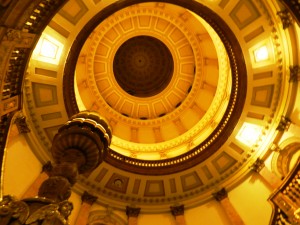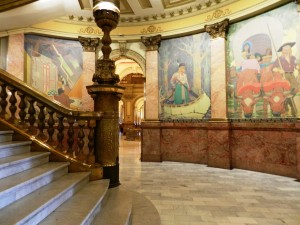» posted on Thursday, October 11th, 2012 by Linda Lou Burton
Golden Arches
 Linda Burton posting from Denver, Colorado – The minute I stepped inside I felt the golden glow. There was no outside light filtering in, but there was warmth and color in every direction. Does it represent the discovery of gold near Denver in 1858? Or is it intended to remind visitors of the abundant golden sunshine Colorado is so proud of? The shapes are pleasing too — curving archways to walk through; an oval opening in the main floor to peer downward, a shiny golden railing at the edge. And just above each architecturally pleasing turn is a stripe of red, yes, I remember, Colorado literally means “color red.” Move on to the grand staircase in the rotunda; “grand” is not an overstating word, it’s gorgeous with more impressive curves and golden shine; above my head is the dazzling dome. Murals in warm and earthy tones curve around this central room; the walls below are a reddish marble like I’ve never seen before. Too much to comprehend, I head for the Visitor’s Desk to get a brochure; it’s time to get some facts.
Linda Burton posting from Denver, Colorado – The minute I stepped inside I felt the golden glow. There was no outside light filtering in, but there was warmth and color in every direction. Does it represent the discovery of gold near Denver in 1858? Or is it intended to remind visitors of the abundant golden sunshine Colorado is so proud of? The shapes are pleasing too — curving archways to walk through; an oval opening in the main floor to peer downward, a shiny golden railing at the edge. And just above each architecturally pleasing turn is a stripe of red, yes, I remember, Colorado literally means “color red.” Move on to the grand staircase in the rotunda; “grand” is not an overstating word, it’s gorgeous with more impressive curves and golden shine; above my head is the dazzling dome. Murals in warm and earthy tones curve around this central room; the walls below are a reddish marble like I’ve never seen before. Too much to comprehend, I head for the Visitor’s Desk to get a brochure; it’s time to get some facts.
 Curious about those red marble walls, I flipped straight to the “materials” page and read “the pink stone is rose onyx from near Beulah, Colorado, never found anywhere else in the world.” It took seven years to complete its installation throughout the building; all the swirls in this distinctive looking marble has caused viewers to spot shapes resembling animals, objects, and people; the most famous are George Washington and Molly Brown. The magnificent grand staircase, I read, has 57 steps and 176 brass balusters, adorned with oak leaves and acorns cast in brass; I spot some angel faces and angel wings too.
Curious about those red marble walls, I flipped straight to the “materials” page and read “the pink stone is rose onyx from near Beulah, Colorado, never found anywhere else in the world.” It took seven years to complete its installation throughout the building; all the swirls in this distinctive looking marble has caused viewers to spot shapes resembling animals, objects, and people; the most famous are George Washington and Molly Brown. The magnificent grand staircase, I read, has 57 steps and 176 brass balusters, adorned with oak leaves and acorns cast in brass; I spot some angel faces and angel wings too.
 And the murals – artist Allen True and poet Thomas Ferril got together to tell the story of Colorado’s water in picture and verse; the eight murals, painted on canvas and then attached, were completed in 1940. I studied the two just beside me; on the first, rugged men paddle a canoe; the verse below says “Then shall the River namers track the sunset, singing the long song to the shining mountain.” The next mural pictures an ox-drawn wagon carrying a pioneer family, the oxen have heads bowed, drinking; the verse is “Here shall the melting snow renew the oxen, here firewood is and here shall men build on.” Every panel stresses the importance of water throughout Colorado’s history.
And the murals – artist Allen True and poet Thomas Ferril got together to tell the story of Colorado’s water in picture and verse; the eight murals, painted on canvas and then attached, were completed in 1940. I studied the two just beside me; on the first, rugged men paddle a canoe; the verse below says “Then shall the River namers track the sunset, singing the long song to the shining mountain.” The next mural pictures an ox-drawn wagon carrying a pioneer family, the oxen have heads bowed, drinking; the verse is “Here shall the melting snow renew the oxen, here firewood is and here shall men build on.” Every panel stresses the importance of water throughout Colorado’s history.
The light fixtures have an interesting past. Electricity was available in Denver in 1886 when construction of the capitol began. But builders didn’t trust it! They insisted on gas lighting instead, but agreed to install fixtures that had the capability of being powered by either gas or electricity. Conversion from gas took place over the years; the last fixture went electric in 1930. 
I’d like to track all the stained glass in the capitol, I read that 16 stained-glass portraits were placed in the dome in 1900 but I can’t really see them; they show 16 individuals who initially contributed to the growth and development of the state. I do see stained glass portraits in the Senate Chambers (where 35 senators meet for 120 days annually); and I see them in the House Chambers (65 representatives). Voting in the Senate is still done by call; the House votes electronically now. They are not completely high-tech yet however; gray steel file cabinets sit beside each desk.
A group of Girl Scouts filed into the House Chambers while I was there, excited young girls hushed to a whisper by their Troop Leader; they took their seats politely on benches at the edge. I’d seen them at different spots around the building; lunching in the cafeteria, peering over the edge of every railing, scrambling up the grand staircase. A citizenship badge is being earned today, I thought. I headed out the door of the Chambers and passed by the Governor’s Office. I could see the Great Seal on the wall; reds and golds the  color scheme of the Seal too, along with a deep blue. The year of statehood, 1876, is prominent; a heraldic shield features three snowcapped mountains and mining tools (I remembered that three peaks over 14,000 feet are visible from Denver). The eye of God is in a triangle at the top; the Latin phrase “Nil Sine Numine” is at the bottom. It means “Nothing Without Providence.”
color scheme of the Seal too, along with a deep blue. The year of statehood, 1876, is prominent; a heraldic shield features three snowcapped mountains and mining tools (I remembered that three peaks over 14,000 feet are visible from Denver). The eye of God is in a triangle at the top; the Latin phrase “Nil Sine Numine” is at the bottom. It means “Nothing Without Providence.”
The guard at the security entrance answered my question about the symbolism of the Colorado flag; blue skies, white snow-capped mountains, red soil, and golden sunshine. He wished me a good day as I exited the building. Outside, the sun was shining too.
 Note: My thanks to Theresa Holst, Manager of Visitor Services, for her kindnesses during my visit, and her answers to my many questions. I’m sorry I never got to Mr Brown’s Attic, an exhibit area located between the third floor and the dome. Those Girl Scouts did though!
Note: My thanks to Theresa Holst, Manager of Visitor Services, for her kindnesses during my visit, and her answers to my many questions. I’m sorry I never got to Mr Brown’s Attic, an exhibit area located between the third floor and the dome. Those Girl Scouts did though!
Capitol Visitor Services, Room 029, Colorado State Capitol, 303-866-2404, Capitol.Tours@State.CO.US, http://www.colorado.gov/capitoltour
For a Virtual Tour and more Colorado history: Colorado State Archives http://www.colorado.gov/dpa/doit/archives/cap/rotunda.htm
